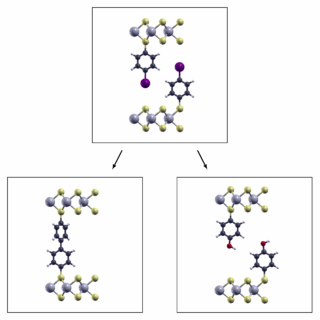Assembly of Vertically Linked Two-DimensionalMaterials via Laser Irradiation
Assembling vertical heterostructures from two-dimensional (2D) materials in a scalable and spatially controlled way is still a major challenge. In a joint work, teams from the Institute of Chemistry and Biochemistry at Freie Universität Berlin, from the Department of Chemistry and Pharmacy at FAU, and from the Chair of Experimental Physics at FAU, showed a new route for fabricating patterned 2D heterostructures, using direct laser writing. Functionalized transition metal dichalcogenide (TMDC) inks were used in combination with a graphene substrate. By local laser irradiation, photochemical reactions in the functional groups are triggered, which are proposed to lead to covalent linking of the TMDC nanosheets and graphene. We contributed through density functional theory calculations of the structures corresponding to intermediate and final stages of the proposed reaction and their phonon modes. Our calculations provide strong support for the interpretation of covalently linking individual layers, which facilitates the heterostructure formation. This study showcases the potential for simple and scalable assembly of customizable 2D heterostructures, including further patterning via photolabile linkers and photoinduced coupling.
For more information, see the publication in: Advanced Functional Materials
X. Chen, S. Wolff, S. Zuieva, R. Schusterbauer, R. Shaikh, C. E. Halbig, A. Habel, R. Gillen, K. C. Knirsch, I. Donskyi, S. Eigler, J. Maultzsch, and A. Hirsch.
Advanced Functional Materials (2025), p. 2425776.
